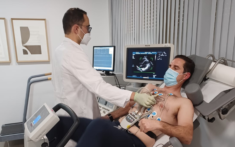With the arrival of summer and exposure to the sun, the word melanoma is heard again. Although this type of skin cancer is one of the least frequent, we can not forget that melanoma is the most aggressive skin cancer, and if it is not diagnosed in time, it can metastasize and be lethal for the human being, its mortality rate being higher.
"The concern is real, since the current data indicate that there is still an increase in its incidence in most countries of the world", explains Dr. Carmen Terencio, dermatologist at the hospital HLA San Carlos and HLA Vistahermosa, and adds that "The incidence in Spain is around 6-7 patients each 100.000 inhabitants / year, and in northern Europe, it is higher due to the phenotypic characteristics of the population. In general in Europe, the incidence doubles every 10-20 years since 1970 and is currently diagnosed around 60.000 annual cases ".
Be careful if you have clear skin, you are older than 60 years or you have many moles
Melanoma is a tumor that arises from the melanocytes, cells that are in the epidermis and that are responsible for making melanin, a pigment necessary to protect us from solar radiation.
It can appear at any age, but its incidence is higher than the 60 years, and people with lighter skin are more likely to have melanoma, which, together with the personal history of sunburn and nevus (moles), constitute the most important risk factors.
In addition, people who have many moles are also more likely to develop this type of cancer. "We must bear in mind that nevi have a high prevalence in the general population and the vast majority are benign proliferations", clarifies the professional, but adds that "There is a type called atypical or dysplastic, which potentially presents a greater transformation to melanoma, and which has a more irregular appearance, is usually asymmetrical or partially return".
Therefore, people who present many moles, and especially with atypical forms, should be periodically checked, where the clinical diagnosis and anatomopathological study are used and, if the dermatologist considers it, they should be excised. For them, the professional clarifies that "The intervention of a melanoma is performed in the 90% of cases on an outpatient basis".
There are different clinico-pathological variants of melanoma, the most frequent being the so-called superficial extension melanoma that corresponds to 60-70% of all those present in the whitest skins. "It usually presents as a dark brown or black macula that can appear on a nevus or on normal skin. This spot is irregular, asymmetrical and has different shades of color ", warns Dr. Terence.
Where to look?
The most frequent location where the melanoma appears is the trunk, followed by the lower extremities, head and upper extremities. And it is advisable to be attentive to areas that are normally less exposed to the sun, such as the legs and back, because they are the first to always burn.
The prevention and early detection of melanomas are of decisive importance in order to reduce the mortality caused by this neoplasm.
"In this sense, the health authorities and dermatological societies carry out information campaigns, so that the population becomes aware and goes to their family doctor or their dermatologist when they believe they have a suspicious skin lesion"explains the dermatologist.
In addition, there is a series of tips that patients can use to perform a self-diagnosis, as is the case of the ABCDE guideline, although at the minimum sign of alarm it is recommended to go to a professional. This simple guideline tries to teach the population to be attentive to the moles of: asymmetry, irregular edges, different color, diameter greater than 6 mm and rapid evolution.
On the degree of sun protection, you have to look for a balance between exposure and protection. "You have to apply the protection correctly, twenty minutes before exposure and most importantly, avoid sunburn and expose yourself to the sun at the recommended hours", advises the specialist, and adds that «el problema de este tipo de patologías es que no son tumores que se desarrollan inmediatamente después del hecho que lo provocan, sino que pueden tardar 20 años, es decir, puedes quemarte de niño y padecer un melanoma cuando tienes 40».
The HLA hospital San Carlos Office has a prestigious team of dermatologists who care for their patients both in the permanent consultations that the center has in Jávea, as in the facilities of the hospital in Denia, and offers an extensive portfolio of services for the diagnosis and treatment of skin diseases, such as chronic sun damage, actinic keratosis, basal cell carcinomas, psoriasis and seborrhea in different parts of the body or vulgar warts.








